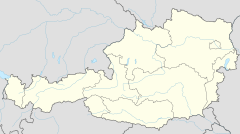| Graz Hauptbahnhof | |||||
|---|---|---|---|---|---|
 Graz Central Station at nighttime Graz Central Station at nighttime | |||||
| General information | |||||
| Other names | Graz Main Station Graz Central Station | ||||
| Location | Europaplatz 8020 Graz Austria | ||||
| Coordinates | 47°4′20″N 15°25′2″E / 47.07222°N 15.41722°E / 47.07222; 15.41722 | ||||
| Owned by | Austrian Federal Railways (ÖBB) | ||||
| Operated by | ÖBB Infra | ||||
| Line(s) | |||||
| Distance |
| ||||
| Platforms | |||||
| Tracks | 9 | ||||
| Connections |
| ||||
| Construction | |||||
| Architect | Wilhelm Aduatz (1956) | ||||
| History | |||||
| Opened | 1847 | ||||
| Rebuilt | 1876 and 1956 | ||||
| |||||
Graz Hauptbahnhof, abbreviated Graz Hbf (German for Graz Main Station; sometimes translated as Graz Central Station), is the main railway station in Graz, the capital of the Austrian federal state Styria. The station is located some 2 kilometres (1.2 mi) west of the city centre, to which it is connected by tram. It is the most frequented railway station in Austria, outside of Vienna.
The station serves as a major node on the Southern Railway, which links it to Vienna in the north, and Slovenia in the south. It is also the terminus of the Styrian Eastern railway line [de], which runs eastwards towards Hungary, and of the local Köflach railway line to the west. In the future, the Koralm Railway will provide a direct link from Graz to Italy via Klagenfurt.
History

The first railway station was opened here in 1847 and due to an increase in passenger numbers a larger station was constructed on the same site between 1871 and 1876.
In 1945 the railway station from 1876 was totally destroyed in allied bombing raids. In 1956 the construction of the current station was completed. The station was built in the typical style of the 1950s and the main ticket hall is now a listed building.
In 2001 the station was modernised and partly rebuilt to incorporate escalators to the platforms and also a small shopping mall.
Project Hauptbahnhof 2020


Since 2010 the station has been adapted for its new role as an international transport hub and to cope with increasing national and regional traffic. When the construction of the Koralm Railway is completed all international traffic from Vienna to Italy will pass through Graz.
This includes rebuilding and lengthening all platforms and the construction of two extra platforms for regional trains. All platforms have new, modern roofing.
One of the two pedestrian tunnels to the platforms has been extended to the Wagner Biro Straße giving access to the station from the west as well.
The railway bridge over the Eggenberger Straße has also been rebuilt to make room for extra tracks.
A new local transport hub for trams and buses has been built on and under the station forecourt to connect four tram lines to the station. Up until recently two of these tramlines used to terminate on the station forecourt while the other two passed the station nearby. To rectify this problem a new subsurface tram stop was built under the station forecourt, enabling all four tram lines to stop outside the main entrance of the station.
Layout
Graz Hauptbahnhof has five platforms serving nine tracks.
Train services
The station is served by the following services:
- RailJet services: Graz - Vienna - Breclav - Brno - Pardubice - Prague
- EuroCity services: Zagreb - Maribor - Graz - Vienna
See also
References
- ^ Eisenbahnatlas Österreich [Austrian railway atlas] (in German) (3rd ed.). Cologne: Schweers + Wall. 2021. pp. 82–83, 101. ISBN 978-3-89494-150-5.
- "Station Graz Hbf". ÖBB.
- "Graz Main Station Local Transport Hub / Zechner & Zechner". www.archdaily.com. Retrieved 15 August 2013.
- ^ "To and From the Graz Central Station". Austrian Federal Railways. Retrieved 14 Aug 2013..
- Schwandl, Robert (2010). Schwandl's Tram Atlas Schweiz & Österreich. Berlin: Robert Schwandl Verlag. ISBN 978 3 936573 27 5. (in German and English)
- "Haltestellenplan" (PDF) (in German). 10 July 2022. Retrieved 5 September 2023.
External links
- [REDACTED] Media related to Graz Hauptbahnhof at Wikimedia Commons

